Learn how to cut carrots into flower shapes for beautiful Japanese food presentation. From simple veggie cutter techniques to hand-carved plum blossoms (Nejiri Ume), I’ll show you step-by-step methods to transform carrots into elegant edible flowers.
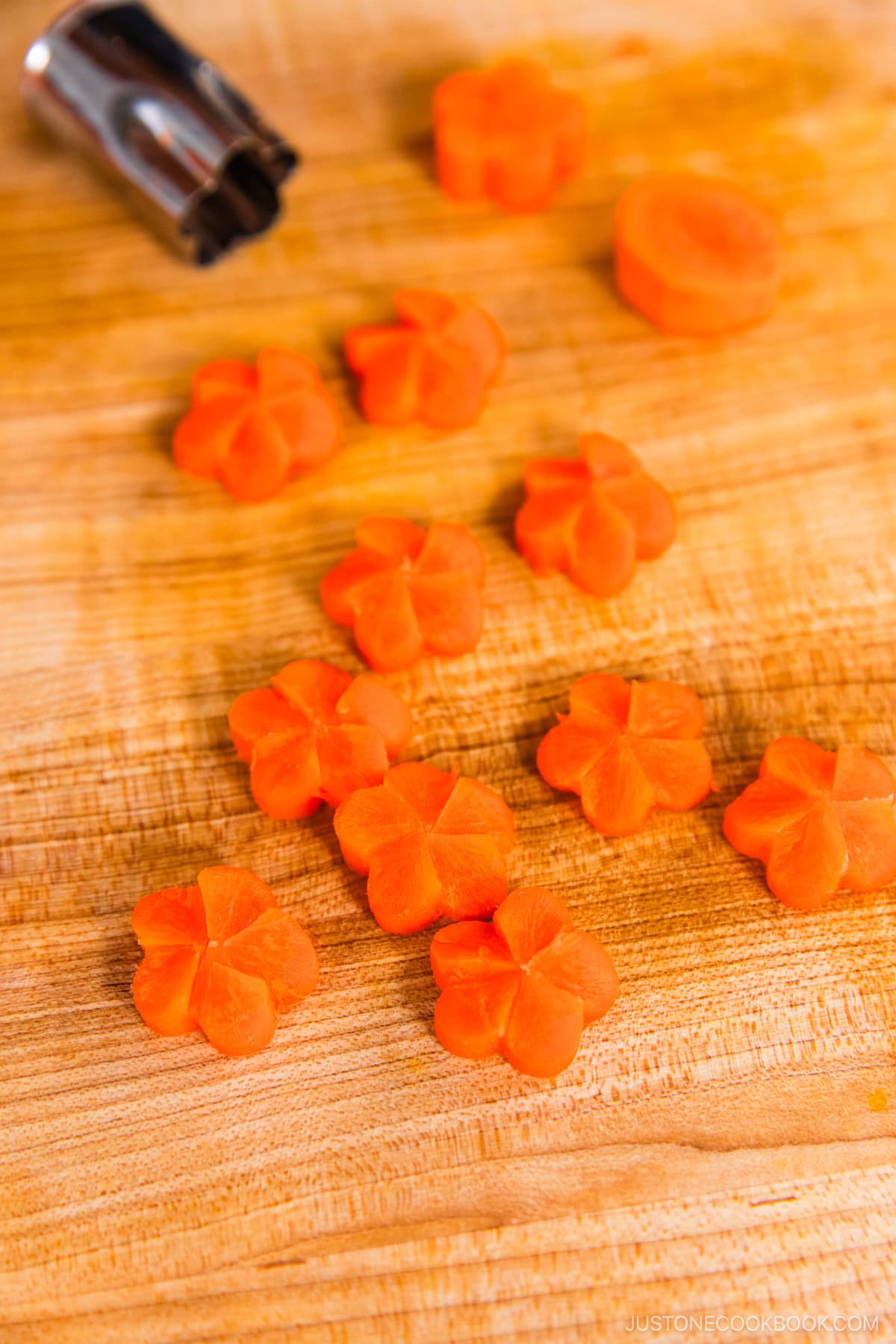
In Japanese cuisine, we add carrot coins shaped like flowers to simmered and hot pot dishes for both celebratory occasions and everyday home cooking. Today, I’ll show you both beginner and advanced methods for How to Cut Carrots into Flower Shapes—especially, iconic Japanese plum blossoms known as Nejiri Ume (ねじり梅). It’s actually easy to do with a little practice, and you’ll love how they enhance your food presentation!
See how I use nejiri ume in my Sukiyaki, Shabu Shabu, and Chikuzenni (Nishime) recipes!

What is Nejiri Ume?
Nejiri ume (ねじり梅) translates to “twisted plum.” We use this decorative cut to carve plum flowers from carrots to cook in hot pots and simmered dishes. Plum trees in Japan are among the first to blossom in the new year, appearing late January to mid-March, depending on the region. The flowers bloom in wintertime when the weather is very cold and symbolize resilience, perseverance, and the promise of spring.
Why I Love Nejiri Ume (Carrot Flowers)
- Enhances presentation – Nejiri ume adds flair and a charming touch to my Japanese cooking, and I love that it takes just a few minutes to make.
- Chose the beginner or advanced method – Punch carrot coins with a veggie cutter for simple flowers, or shape the petals further with a knife for an elegant 3D effect. You’ll quickly master the advanced method with a little practice and patience.
- Versatile for any occasion – These precious flower carrots are a popular addition to everyday meals like bento or to celebratory dishes for osechi ryori (Japanese New Year cuisine) and other special feasts.
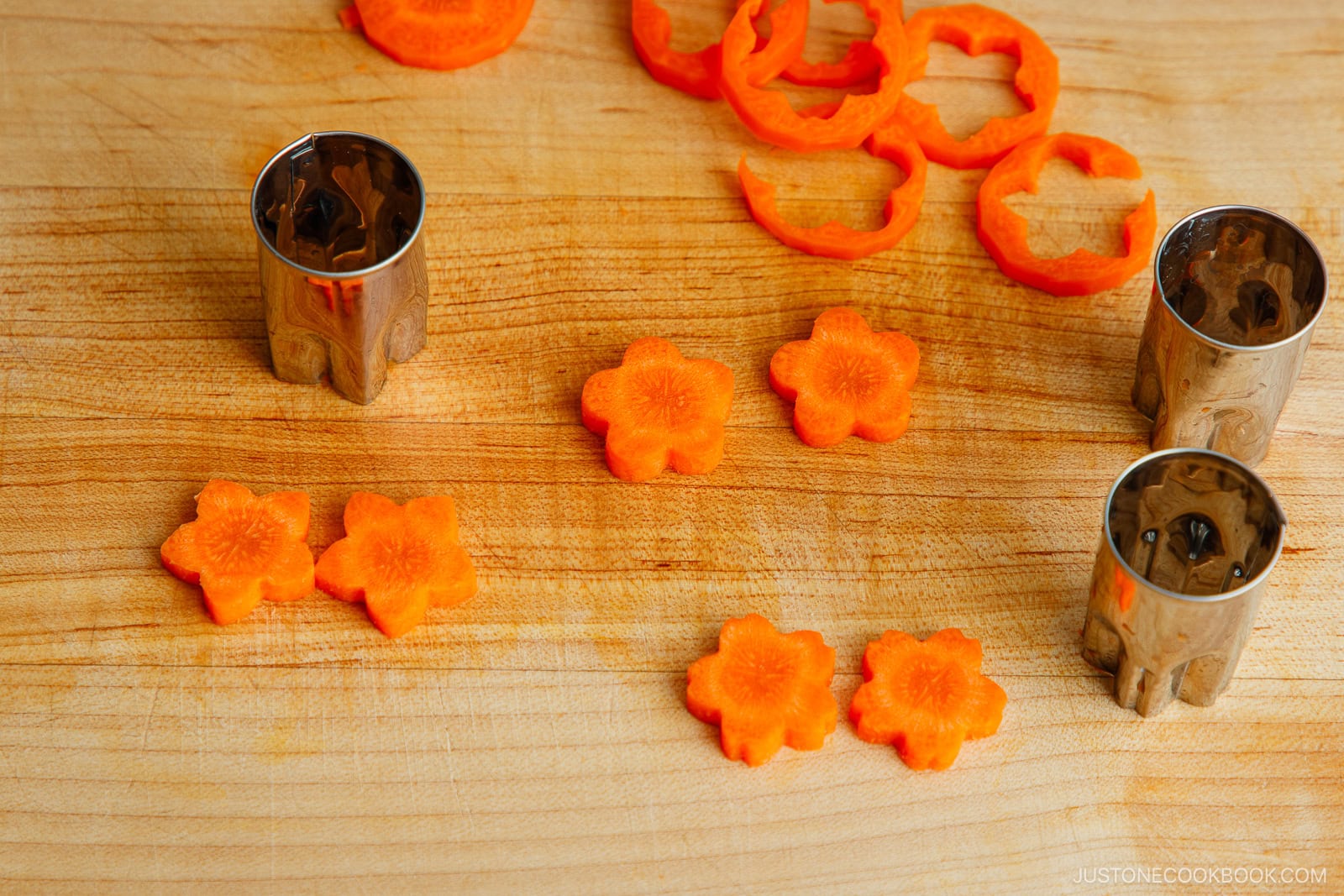
Types of Food for Decorative Flowers
- Carrots (large) for red flowers
- Daikon for white flowers
Find the printable tutorial with measurements below.
Key Kitchen Tools
- vegetable cutter in the shape of a plum blossom, which has rounded and smooth petals. On the other hand, cherry blossoms have a notched or split tip on each petal.
- sharp kitchen knife – I recommend a solid chef’s knife for this task, I use a high-quality Nagomi Damascus Gyuto Chef Knife that you can find at JOC Goods. You could also use a nakiri knife (Japanese vegetable knife) for cutting veggies.
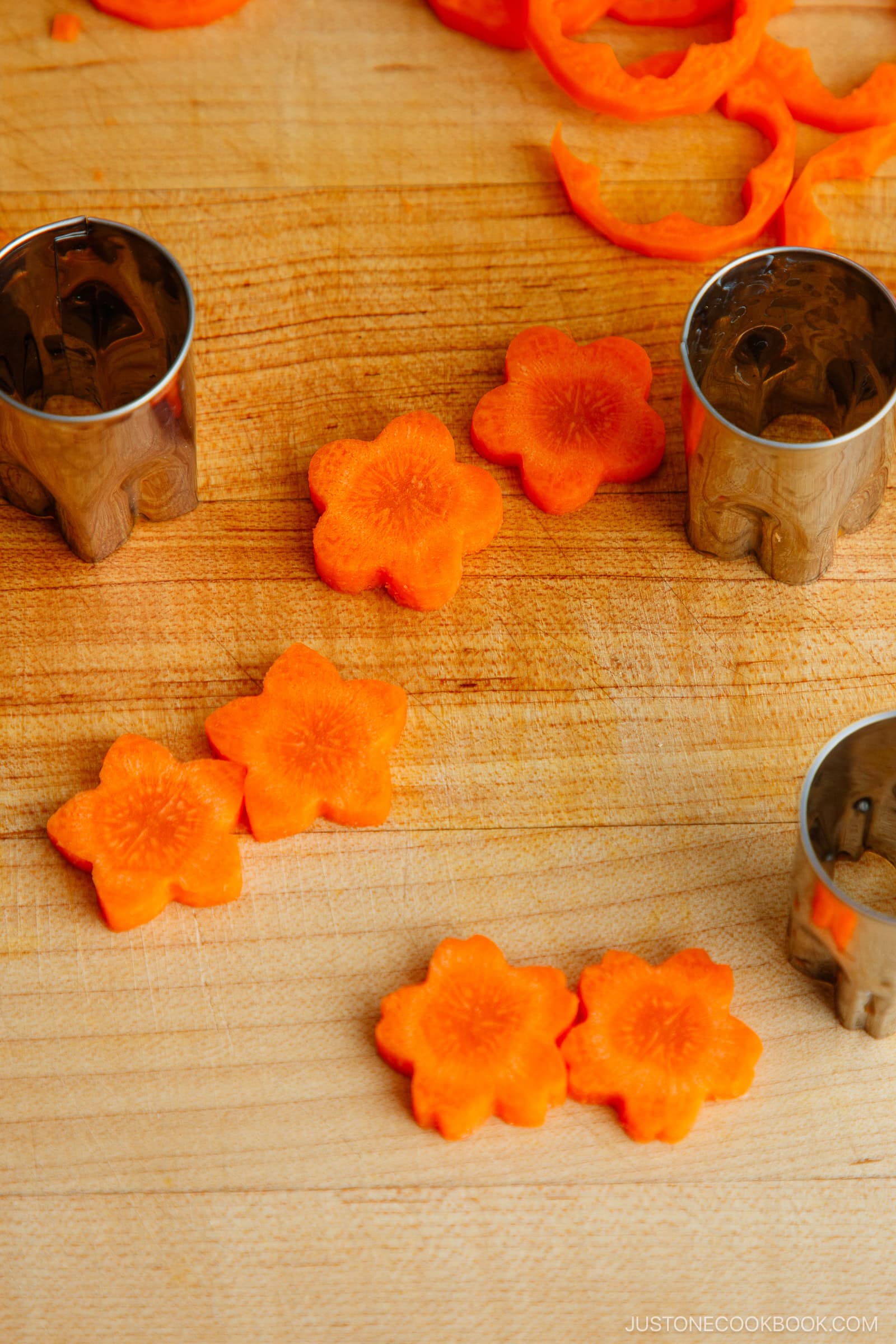
How to Cut Carrots into Flower Shapes
Beginner Method: Vegetable Cutter
- Slice coins and punch. Peel the carrot and cut it crosswise into rounds ¼ inch (6 mm) thick. Cut out flower shapes with a vegetable cutter. Your simple flowers are now ready to use.
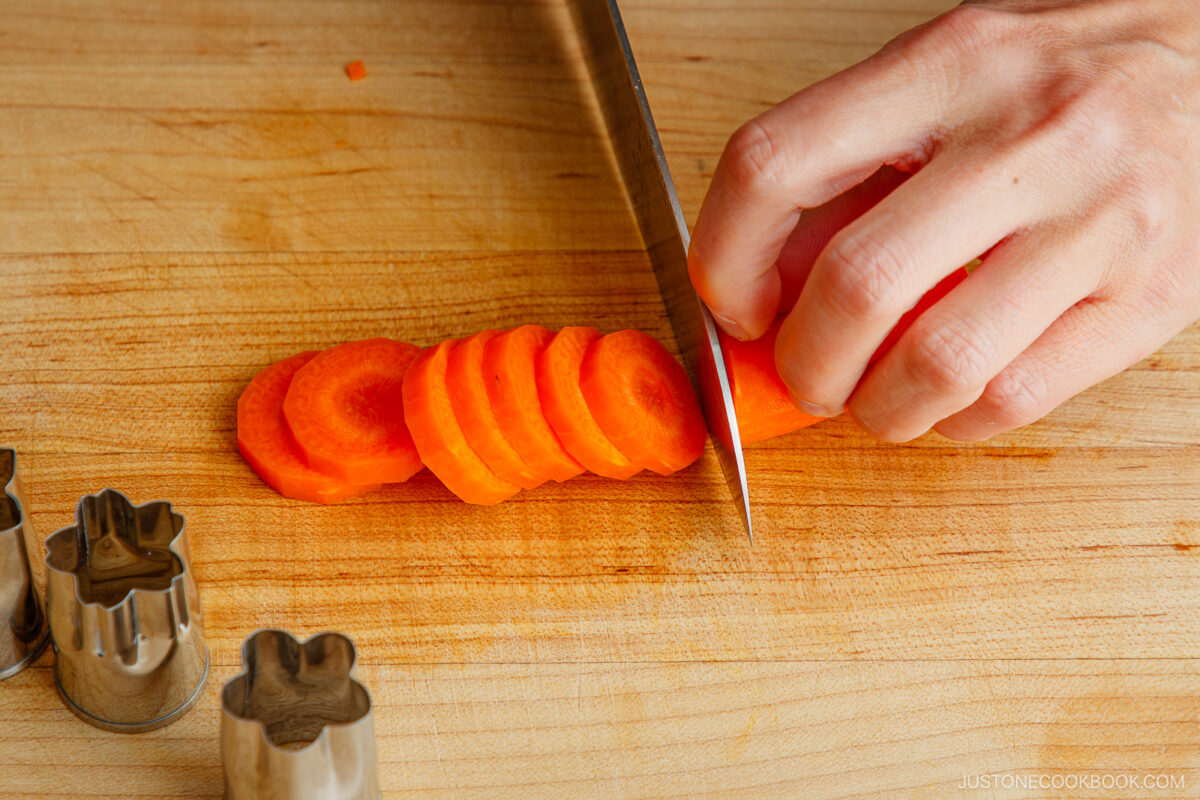
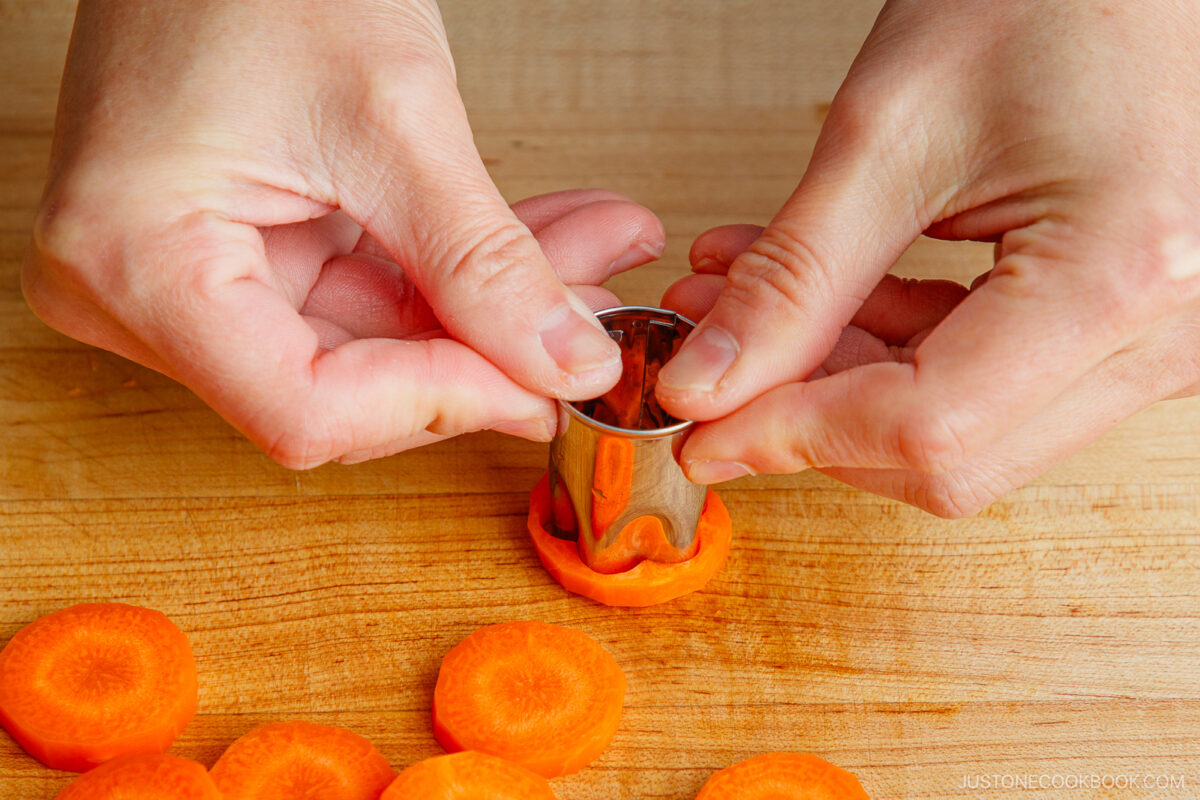
Advanced Method: Decorative Knife Cut
- Slice coins and punch. Peel the carrot and cut it crosswise into rounds ½ inch (1.2 cm) thick. Cut out flower shapes with a vegetable cutter.
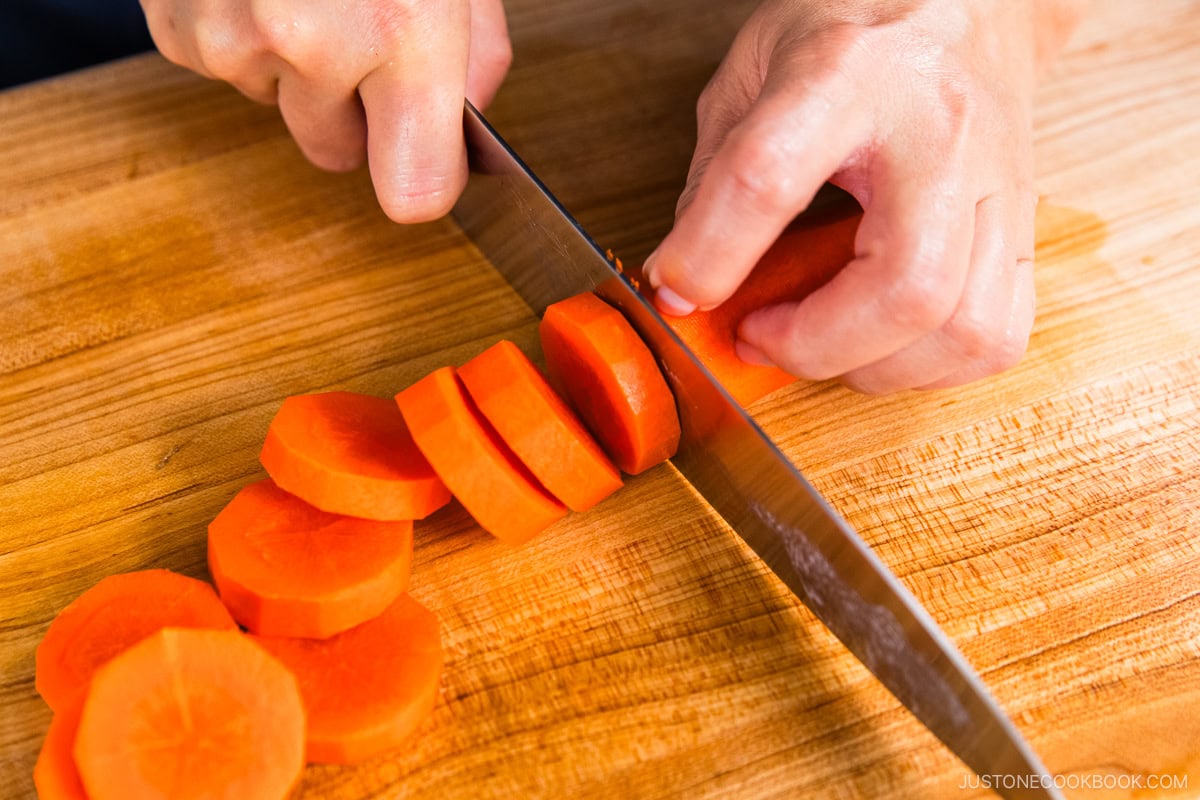
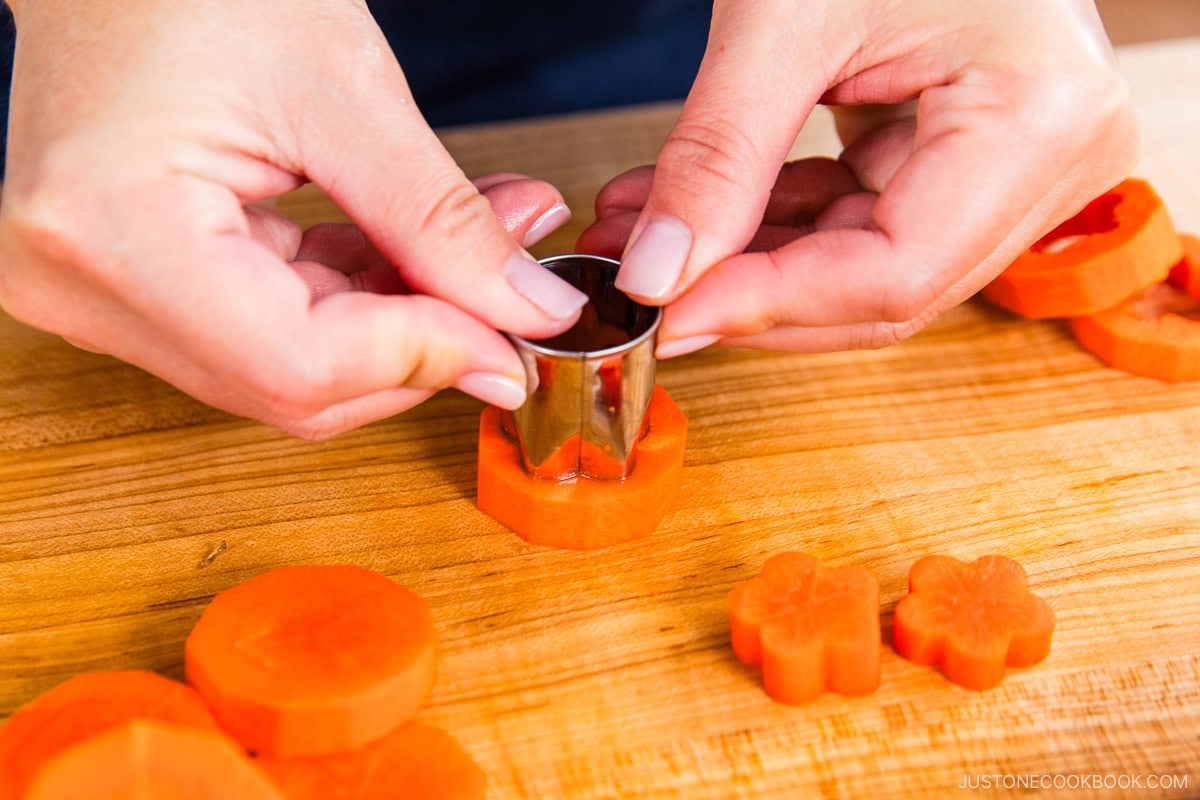
- Cut slits and shave the petal. Use the tip of your knife to score slits ⅛-inch (3-mm) deep between the petals, starting at the edge where the petals meet and ending in the center of the flower. Place your knife blade down the middle of a petal and cut diagonally toward the left (if you’re right-handed) to the slit, shaving off a thin wedge of carrot. Repeat with the other petals.
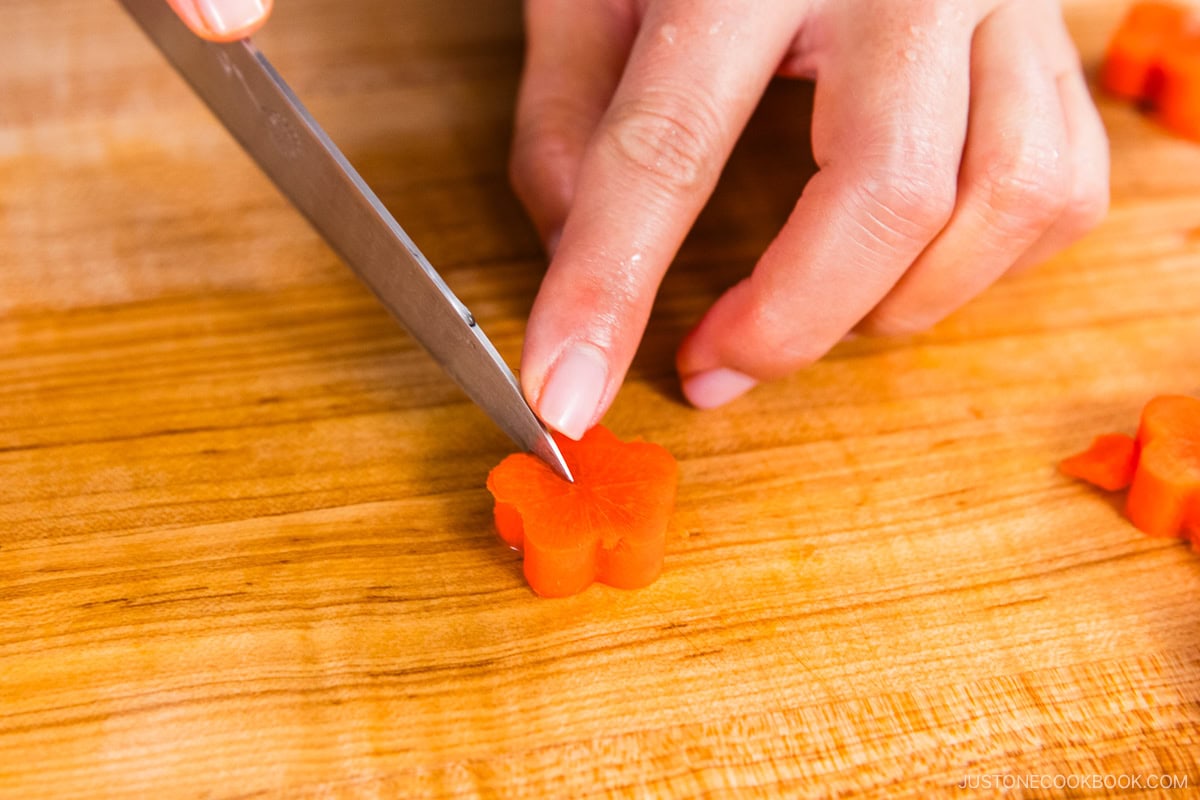
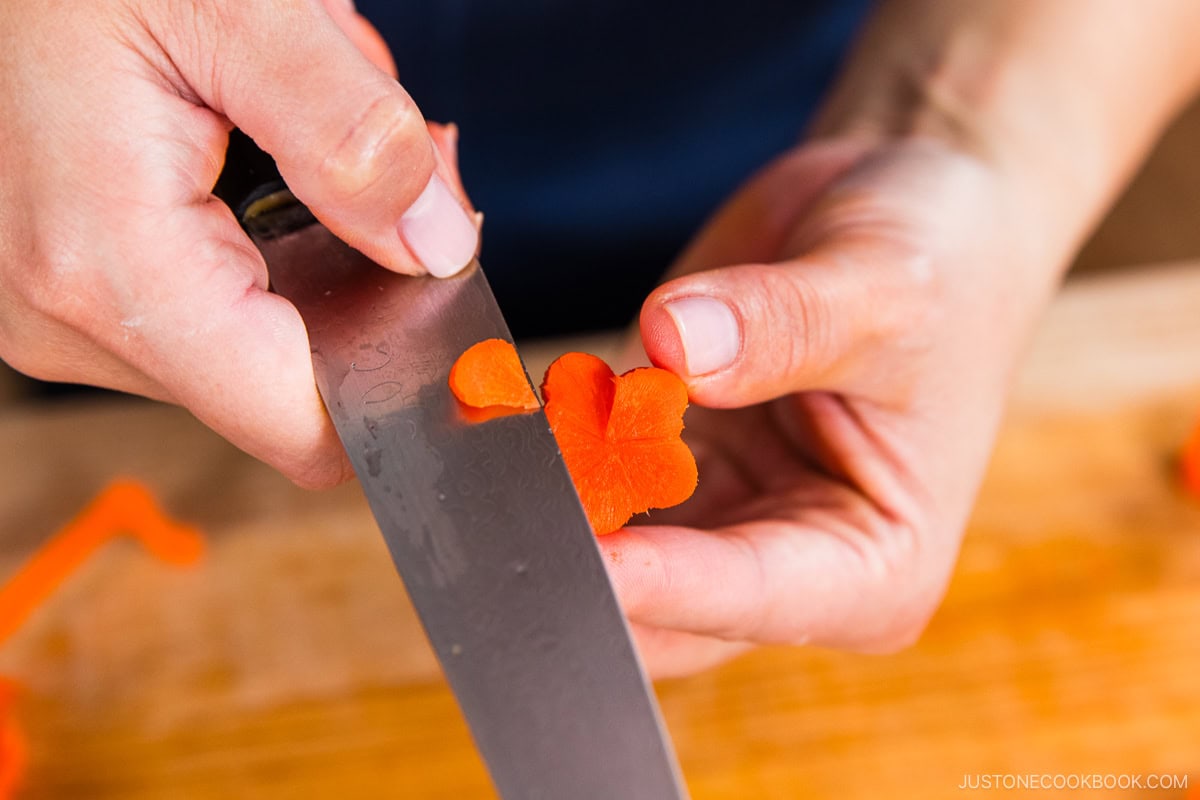
- Repeat with the other petals.
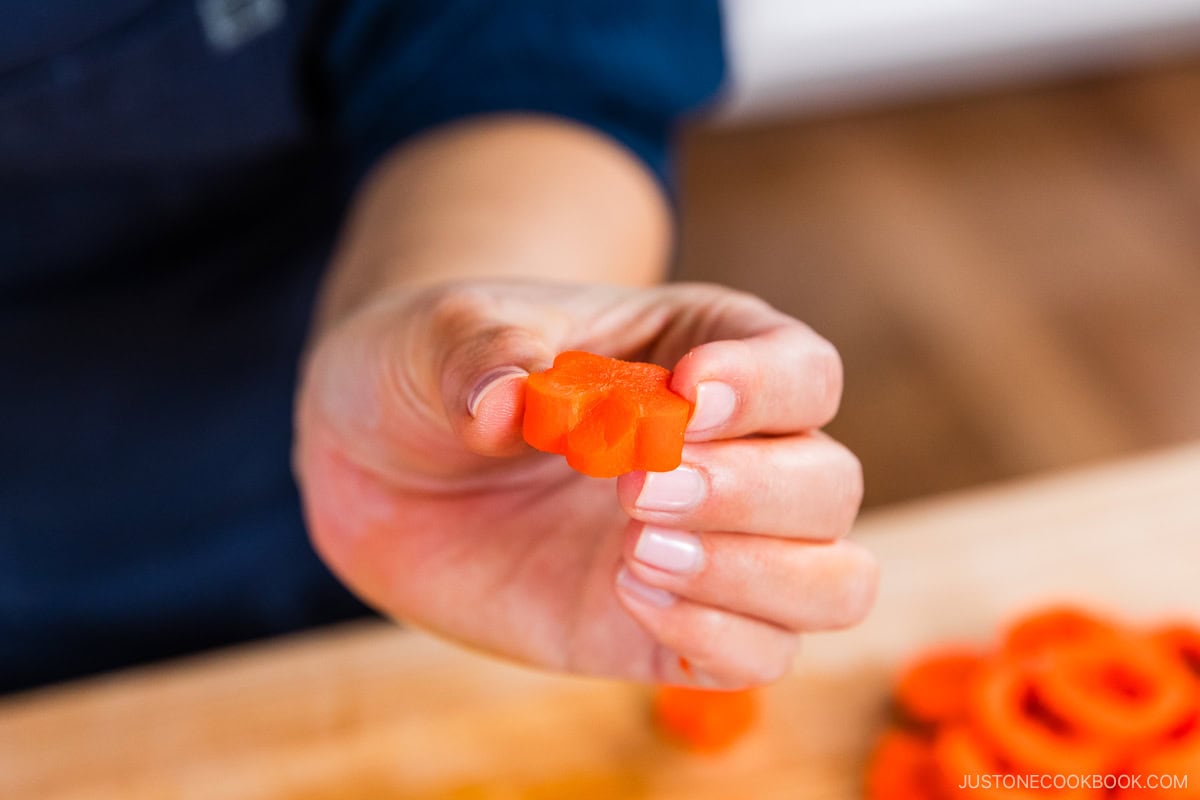

Nami’s Tips
- Use large carrots – To punch out the full flower shape, make sure the carrot’s circumference is slightly bigger than your vegetable cutter.
- Cut the coins thick enough – If you cut the rounds too thin, you won’t have enough thickness to carve the petals on both sides of the flower.
- Make the slit shallow – Score between the petals just ⅛-inch (3-mm) deep. This is just one-quarter of the carrot coin’s total thickness. Keep in mind that you will carve the reverse-side petals as well, so you don’t want to cut too deep.
- Shave diagonally toward the slit – Start at the center line of the petal, and shave off a very thin wedge of carrot on just the left side (if you’re right-handed like me).
- Repurpose the carrot scraps – Don’t throw out the leftover bits—that’s mottainai (wasteful)! I mince the carrot scraps and add them to my Spaghetti Meat Sauce, Japanese Fried Rice with Edamame, or soups.
How to Use Carrot Flowers (Nejiri Ume)
- In simmered dishes – Add it to Chikuzenni (Nishime) and Instant Pot Nishime cooked in dashi, soy sauce, mirin, and sake. It’s a signature recipe of Japanese New Year cuisine and a home cooking classic.
- In hot pots – Plum flower carrots are beautiful in Sukiyaki and Shabu Shabu.

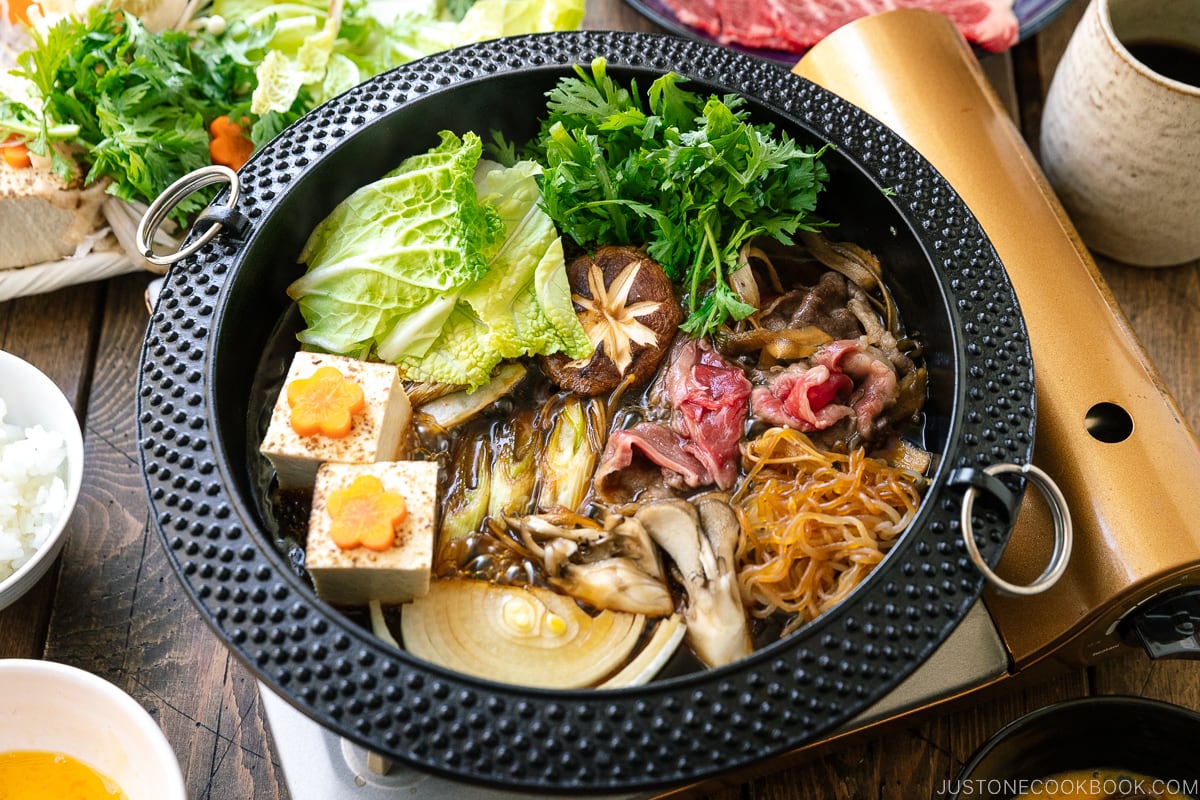
Frequently Asked Questions
What other types of ingredients can I use to make nejiri ume?
We typically make nejiri ume with carrots. You can also make daikon no nejiri ume using daikon radish.
What decorative cut can I use on shiitake mushrooms?
You can cut a decorative flower pattern on shiitake mushroom caps with the unique Japanese cutting technique called Shiitake Hanagiri.

Prep Time: 15 minutes
Total Time: 15 minutes
Japanese Ingredient Substitution: If you want substitutes for Japanese condiments and ingredients, click here.
Peel 1 carrot. Next, you'll need a vegetable cutter in the shape of ume (a Japanese plum blossom). Plum blossom petals have a rounded and smooth tip, while cherry blossom petals have a notched or split tip.
Nami's Tip: Use a large carrot with a diameter equal to or slightly larger than your vegetable cutter. This ensures you get full, clean decorative shapes every time.
For the beginner method, slice the carrot crosswise into coins about ¼ inch (6 mm) thick—just the right thickness for using a vegetable cutter.
For the advanced method, slice the carrot slightly thicker, about ½ inch (1.2 cm). The extra thickness gives you more depth to carve detailed flower shapes for Nejiri Ume.
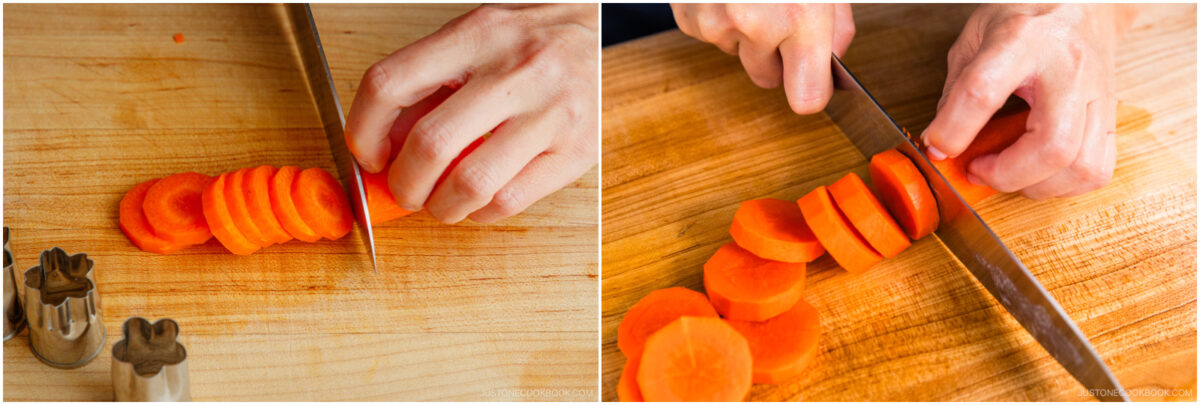
Beginner Method: Vegetable Cutter
Punch out plum flower shapes from the carrot slices with a vegetable cutter. Your simple flower carrots are now ready to use, or you can carve them further with a knife using the advanced method. Nami's Tip: Don't waste the carrot scraps! Mince them and add to Spaghetti Meat Sauce, Japanese Fried Rice with Edamame, or soups.
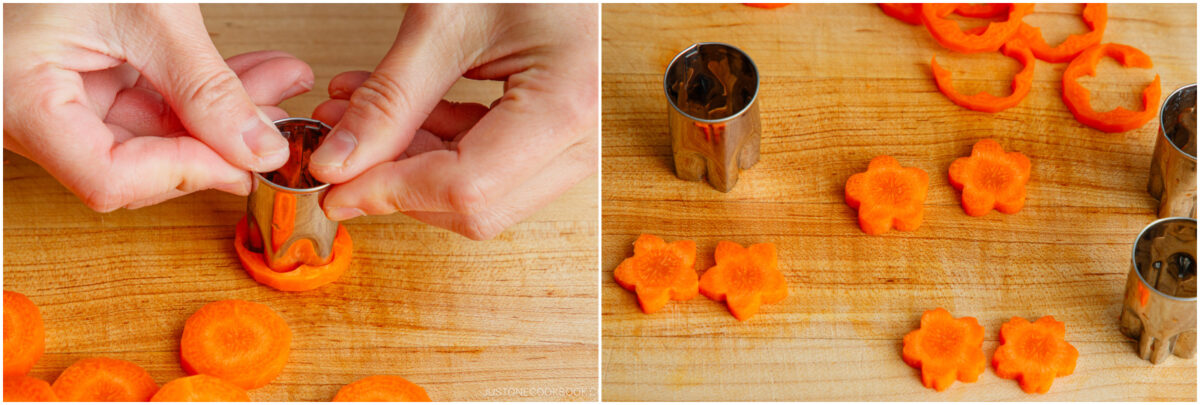
Advanced Method: Decorative Knife Cut
Punch out plum flower shapes from the carrot slices using a vegetable cutter. Then, using the tip of a knife, cut small slits between each pair of petals to define the shape.
Nami’s Tip: I make a ⅛-inch (3 mm) deep cut between the petals—starting where the petals meet at the edge and stopping at the center of the flower.
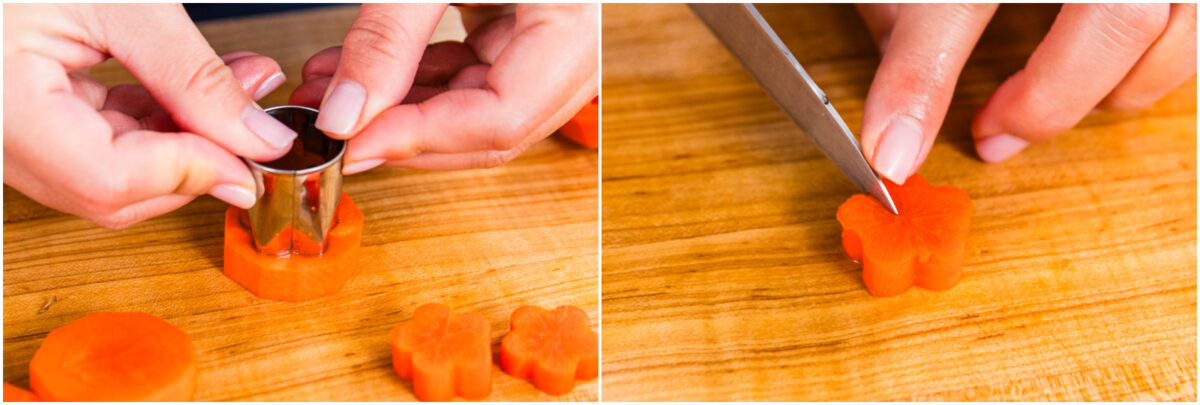
Now, shave the petals to create a more realistic flower shape. Place your knife blade at the center of a petal and angle it slightly. If you're right-handed, cut diagonally toward the left, shaving a thin wedge of carrot toward the slit you made earlier. Repeat with the other petals.
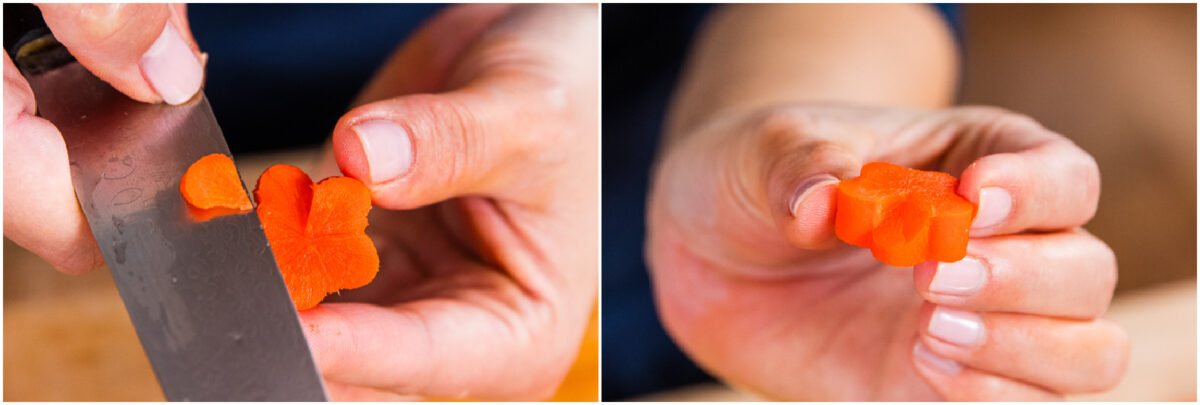
This extra carving step might seem tedious, but it really brings the flower to life—perfect for festive presentations and osechi plating.

To Use the Decorative Flowers
Blanch them in boiling water until tender, about 3–5 minutes, depending on thickness.
Author: Namiko Hirasawa Chen
Course: How to
Cuisine: Japanese
Keyword: cutting technique
©JustOneCookbook.com Content and photographs are copyright protected. Sharing of this recipe is both encouraged and appreciated. Copying and/or pasting full recipes to any website or social media is strictly prohibited. Please view my photo use policy here.
If you made this recipe, snap a pic and hashtag it #justonecookbook! We love to see your creations on Instagram @justonecookbook!
Editor’s Note: This post was originally published on December 24, 2012. It was republished with more helpful information on June 29, 2025.











 English (US) ·
English (US) ·